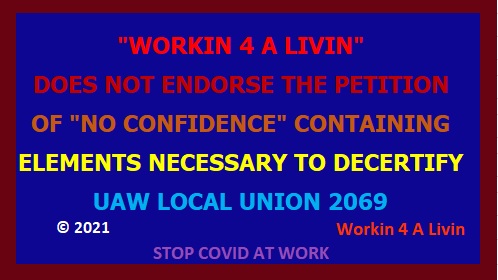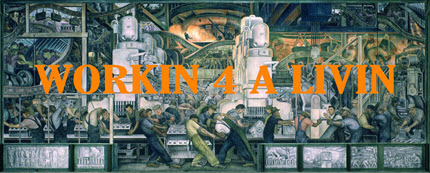
Workin 4 A Livin
OPPOSES “VOTE OF NO CONFIDENCE” OF UAW LOCAL 2069
Anytime a contract negotiation, or presentation is made, there are people who like or hate it. In this instance, for many reasons, the members spoke with a 91% no. Then the anger and frustration rises and people want a better contract. Sometimes those that prey upon member’s anger offer solutions that are not at all what they might seem to be. To that end, and in keeping with Title 29 USC section 157 “protected rights for the benefit of the membership”:
Let it be known that Workin 4 A Livin does not endorse, support or promote the “Vote of No Confidence” petition at UAW Local 2069 representing workers at Volvo Truck.
UAW member(s) that are not in any way associated with Workin 4 A Livin, but clearly some other caucus or organization, are circulating a petition. Their stated goal for this petition is to attain at least 50% plus one signatures.
There are NO provisions what so ever in the UAW Constitution, nor UAW Local Union 2069 By-Laws for any such “Vote of No Confidence”.
In most “lay persons” reading of this it represents a threat to the very NLRB certification of UAW Local Union 2069. Again, this is NOT Titled “Recall”, but rather “Vote of No Confidence”. Such language is found mostly on UNION BUSTING sites.
Further, let it be known that in the absence of any efforts by any other groups, caucuses, the UAW local union or UAW international union itself attempting to prevent such risk of Decertification the following is offered by Workin 4 A Livin.
Below is the petition that is being circulated:

At the bottom it does mention recall, but the again the document is TITLED “Vote of No Confidence”. Very well cloaked language of Union Busters.
—————————-
Here are the local union By-Laws on the matter of Recall – that does require 50% membership signatures. However, this “petition” is not titled “Recall” but rather “Vote of No Confidence.”

The words “No Confidence” do not appear anywhere in the By-Laws:
======================
As proof of the risk of decertification; below is from the “Just Facts” website:
————————————–
Regarding Decertification
*Once private-sector unions are established at workplaces, federal law requires that they remain indefinitely unless employees vote to remove the union, or an employer proves that the majority of employees no longer support the union.[176] [177] [178] [179]
To prove this comment – citations are below. (Again Workin 4 A Livin does NOT Endorse any such action.)
Again, any lay person’s reading of the above is that should the employer Volvo be aware of such a “Vote of No Confidence” petition – clearly this would prove that the majority of the employees of the union no longer support the union, and likely ask the NLRB to decertify UAW Local Union 2069.
=======================
If you do not desire to risk Decertification:
Then, here are Actions Recommended to Prevent risk of Decertification:
- DO NOT SIGN THIS PETITION!
- If you did sign the petition and don’t desire your LU 2069 to risk being decertified: RESCIND your signature by Making two identical statements saying:
===========================
“I hearby rescind my signature on the petition document entitled “This is vote of no confidence in our UAW 2069 local president Matt Blondino, and bargaining chair Greg Shanks. 05/20/2021.”
Signed:______________________, Date:_______________
Received By:__________________, Date:_______________
===========================
You would then sign and date both copies, and give one signed copy to the circulator of the petition, and have that person sign your copy and keep that in your records.
References:
[176] Book: Labour Law in the USA (3rd edition). By Alvin L. Goldman and Roberto L. Corrada. Kluwer Law International, 2011.
Pages 441–442: “A basic principle affecting the rules concerning withdrawal of recognition is the doctrine that once recognized as a bargaining agent, a labor organization is presumed to have continued support from the majority of bargaining unit employees regardless of whether there has been a change in the bargaining unit personnel.”
[177] Webpage: “Decertification Election.” National Labor Relations Board. Accessed June 25, 2014 at <www.nlrb.gov>
“Under certain circumstances, you can vote out or ‘decertify’ your union, or replace it with a different union. At least 30% of your coworkers must sign cards or a petition asking the NLRB [National Labor Relations Board] to conduct an election. Unless a majority of the votes cast in the election are in favor of union representation, the union will be decertified.”
[178] Decision: Levitz Furniture Co. of the Pacific. National Labor Relations Board, March 29, 2001. Decided 4–0. Majority: Truesdale, Liebman, Walsh. Concurring: Hurtgen. <apps.nlrb.gov>
Majority:
In this case we reconsider whether, and under what circumstances, an employer may lawfully withdraw recognition unilaterally from an incumbent union.1 The Board has long held that an employer may withdraw recognition by showing either that the union has actually lost the support of a majority of the bargaining unit employees or that it has a good-faith doubt, based on objective considerations, of the union’s continued majority status. Celanese Corp., 95 NLRB [National Labor Relations Board] 664 (1951). On the same showing of good-faith doubt, an employer may test an incumbent union’s majority status by petitioning for a Board-conducted (RM) election, United States Gypsum Co., 157 NLRB 652 (1966),2 or by polling its employees to ascertain their union sentiments, Texas Petrochemicals Corp., 296 NLRB 1057, 1059 (1989), enfd. as modified 923 F.2d 398 (5th Cir. 1991).
The General Counsel, the Charging Party Union, and the AFL–CIO [American Federation of Labor and Congress of Industrial Organizations] as amicus curiae urge the Board to abandon the Celanese rule and prohibit employers from withdrawing recognition except pursuant to the results of a Board-conducted election. They also oppose lowering the standard that employers must meet to obtain RM elections. Employers urge the Board to retain the Celanese rule but to lower the standard for processing RM petitions.
While this case was pending, the Supreme Court issued Allentown Mack Sales & Service v. NLRB, 522 U.S. 359 (1998), which addressed the Board’s good-faith doubt standard. The Court held that maintaining a unitary standard for an employer’s withdrawal of recognition, filing an RM petition, and polling its employees was rational, but indicated that the Board also could rationally adopt a nonunitary standard, including, in theory, imposing more stringent requirements for withdrawal of recognition.3 The Court also held that the Board’s “good-faith doubt” standard must be interpreted to permit the employer to act where it has a “reasonable uncertainty” of the union’s majority status, rejecting the Board’s argument that the standard required a good-faith disbelief of the union’s majority support.
In addressing the arguments concerning the Celanese rule and the standards for holding RM elections, then, we must take into account the Court’s teachings in Allentown Mack. In particular, we must avoid the confusion over terminology which the Court identified in our application of the good-faith doubt standard.
After careful consideration, we have concluded that there are compelling legal and policy reasons why employers should not be allowed to withdraw recognition merely because they harbor uncertainty or even disbelief concerning unions’ majority status. We therefore hold that an employer may unilaterally withdraw recognition from an incumbent union only where the union has actually lost the support of the majority of the bargaining unit employees, and we overrule Celanese and its progeny insofar as they permit withdrawal on the basis of good-faith doubt. Under our new standard, an employer can defeat a postwithdrawal refusal to bargain allegation if it shows, as a defense, the union’s actual loss of majority status.
We have also decided to allow employers to obtain RM elections by demonstrating good-faith reasonable uncertainty (rather than disbelief) as to unions’ continuing majority status. We adopt this standard to enable employers who seek to test a union’s majority status to use the Board’s election procedures—in our view the most reliable measure of union support—rather than the more disruptive process of unilateral withdrawal of recognition. …
Absent specific statutory direction, the Board has been guided by the Act’s clear mandate to give effect to employees’ free choice of bargaining representatives. The Board has also recognized that, for employees’ choices to be meaningful, collective-bargaining relationships must be given a chance to bear fruit and so must not be subjected to constant challenges. Therefore, from the earliest days of the Act, the Board has sought to foster industrial peace and stability in collective-bargaining relationships, as well as employee free choice, by presuming that an incumbent union retains its majority status.16 Except at certain times, however, that presumption is rebuttable.17 The showing required to rebut the presumption is the subject of this case. …
… In our view, there is no basis in either law or policy for allowing an employer to withdraw recognition from an incumbent union that retains the support of a majority of the unit employees, even on a good-faith belief that majority support has been lost. Accordingly, we shall no longer allow an employer to withdraw recognition unless it can prove that an incumbent union has, in fact, lost majority support.
While adopting a more stringent standard for withdrawals of recognition, we find it appropriate to adopt a different, more lenient standard for obtaining RM elections. Thus, we emphasize that Board-conducted elections are the preferred way to resolve questions regarding employees’ support for unions.42 For that reason, we find it appropriate to abandon the unitary standard for withdrawing recognition and processing RM petitions. Instead, we shall allow employers to obtain RM elections by demonstrating reasonable good-faith uncertainty as to incumbent unions’ continued majority status. …
… An employer who withdraws recognition from a majority union, even in good faith, invades his employees’ Section 7 rights every bit as much as an employer who unwittingly extends recognition to a minority union. Consequently, an employer who withdraws recognition from an incumbent union, in the honest but mistaken belief that the union has lost majority support, should be found to violate Section 8(a)(5). …
We emphasize that an employer with objective evidence that the union has lost majority support—for example, a petition signed by a majority of the employees in the bargaining unit—withdraws recognition at its peril. If the union contests the withdrawal of recognition in an unfair labor practice proceeding, the employer will have to prove by a preponderance of the evidence that the union had, in fact, lost majority support at the time the employer withdrew recognition. If it fails to do so, it will not have rebutted the presumption of majority status, and the withdrawal of recognition will violate Section 8(a)(5). …
In the end, our dispute with our colleague is over whether an incumbent union should continue to be the bargaining representative while its support is being tested in a Board election. He would allow an employer to oust the union on a showing of good-faith uncertainty, and thus to avoid a bargaining obligation until RC election proceedings have run their course. Under our approach, the union remains the bargaining representative, and the employer’s bargaining obligation continues, while the RM (or RD) election proceedings are underway.
[179] Decision: Levitz Furniture Co. of the Pacific. National Labor Relations Board, March 29, 2001. Decided 4–0. Majority: Truesdale, Liebman, Walsh. Concurring: Hurtgen. <apps.nlrb.gov>
Concurrence:
In sum, my colleagues have subjected employers to a guessing game. If the employer guesses wrongly, the employer violates the Act, notwithstanding his good faith. I prefer that these matters not be the subject of a guessing game. They should be a matter of good faith. If the employer has a good-faith uncertainty as to majority status, the employer can withdraw recognition. If the employer has a good-faith belief of majority status, he can continue recognition.4
My colleagues say that there is a way out of the dilemma, viz the employer can file an RM [Board-conducted election] petition and obtain a Board election. And, in this regard, they say that they would permit the processing of an RM petition if there is uncertainty as to the Union’s majority status. I agree with this RM standard.5 However, I do not agree that the RM petition offers a solution to the problem discussed above. That is, it does not obviate the necessity for the extant rule which grants employers the option of withdrawal of recognition on a showing of uncertainty as to the union’s majority status. My reasons are set forth below.
RM petitions are subject to the “blocking charge” principle. Faced with an RM petition, unions can file charges to forestall or delay the election. Concededly, in some situations, the Regional Director can dismiss the charges or can decide that the charges, even if meritorious, would not preclude a valid election. However, that determination requires investigatory time. During that time, the employer must continue recognition of the incumbent Union.
Further, the Regional Director also has the power to issue complaint, and the authority to conclude that the charges do preclude a valid election. The Board has no power to review the former determination, and the Board reviews the latter only under an “abuse of discretion” standard. If the Regional Director so concludes, the charge will block the election for the prolonged period during which the charge/complaint is litigated. Although the employer could settle the case, he may not wish to do so if he believes that he has a valid defense. Further, even if the employer litigates and wins after prolonged litigation, the block will be removed only after that litigation. In the meantime, the employer must continue recognition of the incumbent.
In addition, even if there is no blocking charge, or if the block is removed, the election will not necessarily resolve the question concerning representation. In those cases where the union loses the election, the union can file objections and/or challenges. There is often a prolonged period for the litigation of these matters. The employer must recognize the incumbent during the period of this litigation.
In sum, the RM road can be a long and difficult one. During this prolonged period, the employer must continue recognition, even though there is good-faith uncertainty as to the union’s majority status. In my view, it is far better to resolve the matter by having an RC election. That is, after the employer has withdrawn recognition based on a good-faith uncertainty (a lawful withdrawal in my view), the union can immediately file an RC petition. Although the union could file blocking charges, its interest presumably would be to have a quick election and resume its representation status. Further, the Board correctly gives a high priority to processing such petitions as expeditiously as possible. Thus, I would continue this approach. It comports with current law and procedures, and it is not shown to be deficient. …
Finally, my colleagues argue that their rule is justified by a sense of parity. They note that an employer has a right to an election where the union seeks to become the representative, and thus, a union should be given an election when the employer seeks to terminate the relationship. The argument has no merit. The situations are not parallel. In the former situation, the union is seeking an election as soon as possible, and thus, is reluctant to file blocking charges. In the latter situation, the union is seeking to delay the election as much as possible, and thus, has an interest in filing blocking charges.
Because there are no valid reasons for reversing the extant rule, and because the new rule is imprudent and unfair, I do not embrace the new rule.
=======END OF JUST FACTS======
God Bless Our Union The UAW!
Workin 4 A Livin is about the meaning of work for men and women from all backgrounds – in the union and non-union jobs – who are working for a living every day at their job. For them to get the latest union news, to discuss and learn about the meaning of work within labor unions. We invite you to join us, our podcasts are on I-Tunes, Stitcher, Player. FM and Blog Talk Radio; and can be found on the top right of our website “workin4alivin .com”.
Our email address: Workin4ALivin@Workin4ALivin.com
Follow Us On Twitter: @4_workin

For more information about other labor issues visit Workin 4 A Livin.
